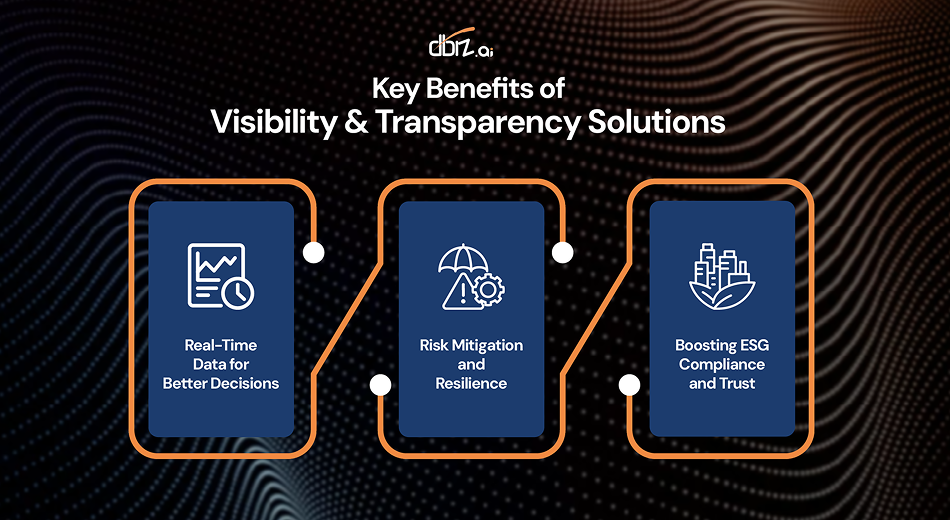Table of Contents
Introduction to Supply Chain Visibility & Transparency Solutions
In today’s fast-paced and highly competitive global marketplace, supply chain visibility and transparency have become essential for operational efficiency, risk mitigation, and customer trust. As supply chains grow more complex and interconnected, businesses face increasing pressure to ensure real-time insights, end-to-end traceability, and accountability across every touchpoint.
Understanding the Importance of Supply Chain Visibility & Transparency
What Do Visibility and Transparency Really Mean?
- Visibility refers to the internal capability of tracking goods, processes, and data across the supply chain in real time.
- Transparency is the external sharing of that data with stakeholders such as customers, partners, and regulators to build trust and improve accountability.
Together, these pillars drive informed decision-making and build a resilient supply chain that can adapt to disruptions, reduce risk, and enhance operational efficiency.
Key Benefits of Visibility & Transparency Solutions

Real-Time Data for Better Decisions
Access to real-time data allows businesses to respond instantly to disruptions—rerouting shipments, reallocating resources, and adjusting production schedules to maintain customer satisfaction and protect the bottom line.
Risk Mitigation and Resilience
Visibility across suppliers, logistics providers, and manufacturers helps identify weak links before they result in delays, compliance violations, or reputational damage.
Boosting ESG Compliance and Trust
With growing emphasis on ethical sourcing and sustainability, transparent supply chains provide the data needed for ESG reporting and align with consumer expectations.
Core Technologies Powering Visibility Solutions

Artificial Intelligence (AI) and Predictive Analytics
AI systems forecast demand, analyse disruptions, and provide predictive insights, helping businesses avoid stockouts or overproduction.
Internet of Things (IoT) and Sensors
IoT devices track goods in transit, monitor storage conditions, and provide live location updates—ensuring complete traceability.
Blockchain for Trust and Verification
Blockchain ensures tamper-proof recording of transactions, enabling stakeholders to verify product origin, authenticity, and handling history.
Centralized Dashboards for Control Tower Visibility
Custom dashboards consolidate supply chain KPIs, offering a visual and interactive view of performance metrics such as order accuracy, shipping delays, and lead times.
Building Transparent and Collaborative Supply Chains
Supplier Engagement and Data Sharing
Establishing a clear communication channel and expectations for data sharing with suppliers ensures alignment and reduces friction in operations.
Integrated Management Systems
Connecting ERP, TMS, WMS, and CRM platforms enhances the seamless flow of data across business functions and stakeholders.
Audits and Compliance Tracking
Automated documentation, supplier scorecards, and digital auditing tools ensure compliance with international trade, labour, and environmental laws.
Challenges in Implementing Visibility & Transparency
Despite the numerous advantages, companies often face hurdles such as:
- Data silos and fragmented systems
- Lack of real-time insights from third-party logistics partners
- Resistance to change within internal teams or suppliers
- Limited budget for technology adoption
Overcoming these challenges requires strategic investment, stakeholder training, and choosing the right solution providers.
Real-World Use Cases and Industry Impact
- Retail & eCommerce benefit from last-mile delivery tracking and inventory optimization.
- Healthcare & Pharmaceuticals use real-time tracking to ensure cold chain compliance.
- Automotive and Aerospace industries rely on visibility to manage complex supplier networks and quality assurance.
Why Visibility and Transparency Matter
Risk Management Through Real-Time Data
Accurate, up-to-the-minute data empowers businesses to mitigate risks before they escalate. Whether it's geopolitical disruption, compliance failure, or supplier delays, real-time alerts ensure proactive action, not reactive damage control.
Boosting Operational Efficiency
Integrated platforms consolidate fragmented systems (ERP, WMS, TMS), improving supply chain operations and enabling faster decisions. This results in improved bottom line performance and smarter allocation of resources.
ESG Compliance and Stakeholder Trust
In an era of Environmental, Social, and Governance (ESG) accountability, supply chain transparency helps meet sustainability mandates while winning the confidence of customers, investors, and regulators.
Industries Benefiting from These Solutions
Manufacturing
Leading manufacturers implement digital twins and automated systems to monitor inventory and ensure uninterrupted production cycles—even during market volatility.
Retail & eCommerce
Retailers need end-to-end visibility to meet just-in-time delivery expectations and manage complex warehouse networks. Real-time insights help avoid stockouts and overstocks.
Pharmaceuticals & Food Supply
Regulated industries rely heavily on traceability to ensure product safety, compliance, and audit readiness. Visibility solutions help avoid recalls and improve consumer trust.
Conclusion
In an era of global uncertainty and heightened consumer awareness, supply chain visibility & transparency solutions are foundational to operational success. These tools not only enhance resilience but also support sustainability, improve trust, and unlock efficiencies across the value chain.
Frequently Asked Questions
1.What is the difference between supply chain visibility and transparency?
Visibility is internal real-time monitoring, while transparency involves sharing that data with external stakeholders.
2.Why is supply chain transparency essential for ESG compliance?
It ensures traceability in sourcing, manufacturing, and labour practices—critical for meeting environmental and ethical standards.
3.What industries benefit the most from visibility solutions?
Retail, manufacturing, pharmaceuticals, food & beverage, and logistics sectors benefit significantly from real-time tracking and insights.
4. How does blockchain support supply chain transparency?
Blockchain records product movement in a tamper-proof ledger, ensuring authenticity, traceability, and reduced fraud.
5.What should be the first step in implementing visibility tools?
Start with a visibility audit, identify data gaps, and then integrate digital platforms like ERPs and dashboards to unify your operations.
Explore other articles:

AI-Powered Supply Chain Optimization
Leverages AI to streamline operations, reduce costs, and improve supply chain efficiency.

AI-Driven Customer & Partner Portals
Personalized, intelligent portals enhancing engagement, collaboration, and efficiency with customers and partners.

Low-Code Port Community Systems (PCS) for Paperless Ports
Build scalable, secure, and efficient maritime applications faster with low-code technology.


